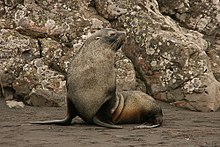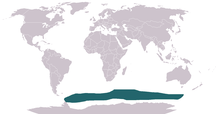Antarctic fur seal
The Antarctic fur seal (Arctocephalus gazella), is a type of seal in the genus Arctocephalus. Even though the name has Antarctic in it, it does not live in Antarctica. The Antarctic fur seal mostly lives in Subantarctic islands.[2]
| Antarctic fur seal | |
|---|---|

| |
| Male on King George Island | |
| Scientific classification | |
| Domain: | Eukaryota |
| Kingdom: | Animalia |
| Phylum: | Chordata |
| Class: | Mammalia |
| Order: | Carnivora |
| Clade: | Pinnipedia |
| Family: | Otariidae |
| Genus: | Arctocephalus |
| Species: | A. gazella
|
| Binomial name | |
| Arctocephalus gazella Peters, 1875
| |

| |
| Antarctic fur seal range | |
Description
changeAdult males are dark brown in colour. Females and young ones tend to be paler, almost grey with lighter undersides. Young ones are dark brown at birth, almost black in color.
Males are larger than females. Males can grow up to 2 m (6.5 ft) long. Males can also weigh 133 kg (293 lb). Females can grow up to 1.4 m (4.6 ft) long. Females can weight 34 kg (74.9 lb). At birth, the average length is 67.4 cm (58–66). The average weight for young ones is 5.9 kg (4.9–6.6) in males and 5.4 kg (4.8–5.9) in females.
Male Antarctic fur seals live up to 20 years. Females can live up to 24 years.
Distribution
changeAntarctic fur seals are thought to be the most abundant type of fur seal. The largest gathering happens on South Georgia. The estimate for South Georgia is 4.5-6.2 million Antarctic fur seal and 46,834 at Bouvetøya.[3]
Breeding colonies are found at South Georgia, South Sandwich Islands, South Orkney Islands, South Shetland Islands and Bouvetøya in the Southern Atlantic Ocean; Marion Island, Crozet Islands, Kerguelen Island and Heard Island in the Southern Indian Ocean; and Macquarie Island in the Southern Pacific Ocean. During winter, Antarctic fur seals range includes Antarctica to the Falkland Islands, and southern Argentina and Chile, reaching as far as the Mar del Plata and Gough Island.[4]
Feeding
changeIn the Atlantic region, the Antarctic fur seal usually eats Antarctic krill. In the Indian Ocean, they mostly eat fish and squid. Sometimes, penguins are eaten by male Antarctic fur seals.
References
change- ↑ Aurioles, D. & Trillmich, F. (2008). "Arctocephalus gazella". IUCN Red List of Threatened Species. 2008. Retrieved 29 January 2009.
- ↑ Aurioles, D. & Trillmich, F. (2008). "Arctocephalus gazella".
{{cite web}}: CS1 maint: multiple names: authors list (link) - ↑ "Scientific Committee for Antarctic Research Expert Group on Seals Report" (PDF). Archived from the original (PDF) on 2022-01-27. Retrieved 2020-08-26.
- ↑ Arthur B, Hindell M, Bester M, De Bruyn PN, Trathan P, Goebel M, Lea MA (2017). "Winter habitat predictions of a key Southern Ocean predator, the Antarctic fur seal (Arctocephalus gazella)" (PDF).
{{cite web}}: CS1 maint: multiple names: authors list (link)
